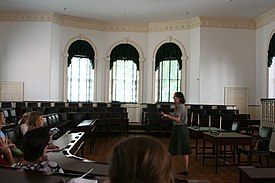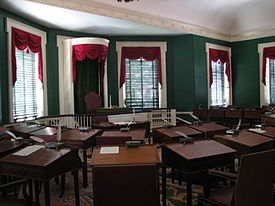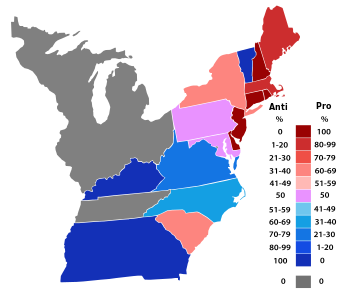2nd United States Congress: Difference between revisions
Rescuing 1 sources and tagging 0 as dead. #IABot (v1.2.4) |
|||
| Line 504: | Line 504: | ||
*[http://memory.loc.gov/ammem/amlaw/lwsjlink.html Senate Journal, First Forty-three Sessions of Congress] |
*[http://memory.loc.gov/ammem/amlaw/lwsjlink.html Senate Journal, First Forty-three Sessions of Congress] |
||
*[http://memory.loc.gov/ammem/amlaw/lwhjlink.html#anchor2 House Journal, First Forty-three Sessions of Congress] |
*[http://memory.loc.gov/ammem/amlaw/lwhjlink.html#anchor2 House Journal, First Forty-three Sessions of Congress] |
||
*[http://www.gpoaccess.gov/serialset/cdocuments/hd108-222/index.html Biographical Directory of the U.S. Congress] |
*[https://web.archive.org/web/20060601025644/http://www.gpoaccess.gov/serialset/cdocuments/hd108-222/index.html Biographical Directory of the U.S. Congress] |
||
*[http://clerk.house.gov/art_history/house_history/index.html U.S. House of Representatives: House History] |
*[http://clerk.house.gov/art_history/house_history/index.html U.S. House of Representatives: House History] |
||
*[http://www.senate.gov/pagelayout/reference/two_column_table/stats_and_lists.htm U.S. Senate: Statistics and Lists] |
*[http://www.senate.gov/pagelayout/reference/two_column_table/stats_and_lists.htm U.S. Senate: Statistics and Lists] |
||
Revision as of 18:14, 29 September 2016
| 2nd United States Congress | |
|---|---|
1st ← → 3rd | |
 Congress Hall (2007) | |
March 4, 1791 – March 4, 1793 | |
| Members | 28–30 (two additions) (with one vacancy) senators 67–69 (two additions) (with 1-3 vacancies) representatives |
| Senate majority | Pro-Administration, then Anti-Administration |
| Senate President | John Adams (P) |
| House majority | Pro-Administration |
| House Speaker | Jonathan Trumbull, Jr. (P) |
| Sessions | |
| Special: March 4, 1791 – March 4, 1791 1st: October 24, 1791 – May 8, 1792 2nd: November 5, 1792 – March 2, 1793 (lame duck) | |


The Second United States Congress, consisting of the United States Senate and the United States House of Representatives, met at Congress Hall in Philadelphia, Pennsylvania from March 4, 1791 to March 4, 1793, during the third and fourth years of George Washington's Presidency. The apportionment of seats in the House of Representatives was based on the provisions of Article I, Section 2, Clause 3 of the United States Constitution. Additional House seats were assigned to the two new states of Vermont and Kentucky. Both chambers had a Pro-Administration majority.
Major events
- April 5, 1792: President George Washington used the veto for the first time, vetoing a bill designed to apportion representatives among U.S. states.
- October 13, 1792: Foundation of Washington, D.C.: The cornerstone of the United States Executive Mansion, now known as the White House, was laid.
Major legislation
- February 20, 1792: Postal Service Act, Sess. 1, ch. 7, 1 Stat. 232, established the U.S. Post Office
- April 2, 1792: Coinage Act of 1792, Sess. 1, ch. 16, 1 Stat. 246, established the United States Mint and regulated coinage
- April 14, 1792: Apportionment Act of 1792, Sess. 1, ch. 23 1 Stat. 253, increased the size of the House of Representatives from 69 seats in the 2nd Congress to 105 in the 3rd and apportioned those seats among the several states according to the 1790 Census
- May 2, 1792: First Militia Act of 1792, Sess. 1, ch. 28, 1 Stat. 264, enabled the President to call in militia in case of invasion or rebellion, while providing for the organizations of state militias
- May 8, 1792: Second Militia Act of 1792, Sess. 1, ch. 33, 1 Stat. 271
- February 12, 1793: Fugitive Slave Act of 1793, Sess. 2, ch. 7, 1 Stat. 302
- March 2, 1793: Judiciary Act of 1793 (including Anti-Injunction Act), Sess. 2, ch. 22, 1 Stat. 333
States admitted
- March 4, 1791: Vermont was admitted as the 14th state, 1 Stat. 191
- June 1, 1792: Kentucky was admitted as the 15th state, 1 Stat. 189
Constitutional amendments
- December 15, 1791: The United States Bill of Rights, the first ten amendments to the United States Constitution, were ratified by the states.
Party summary
There were no political parties in this Congress. Members are informally grouped into factions of similar interest, based on an analysis of their voting record.[1]
Details on changes are shown below in the "Changes in membership" section.
Senate
During this congress, two new Senate seats were added for each of the new states of Vermont and Kentucky.
| Faction (shading shows control) |
Total | Vacant | ||
|---|---|---|---|---|
| Anti- Administration (A) |
Pro- Administration (P) | |||
| End of previous congress | 8 | 18 | 26 | 0 |
| Begin | 8 | 17 | 25 | 1 |
| End | 13 | 30 | 0 | |
| Final voting share | 43.3% | 56.7% | ||
| Beginning of next congress | 14 | 16 | 30 | 0 |
House of Representatives

During this congress, two new House seats were added for each of the new states of Vermont and Kentucky. (Sess. 3, ch. 9, 1 Stat. 191)
| Faction (shading shows control) |
Total | Vacant | ||
|---|---|---|---|---|
| Anti- Administration (A) |
Pro- Administration (P) | |||
| End of previous congress | 28 | 36 | 64 | 1 |
| Begin | 29 | 39 | 68 | 1 |
| End | 32 | 40 | 72 | |
| Final voting share | 44.4% | 55.6% | ||
| Beginning of next congress | 55 | 50 | 105 | 0 |
Leadership

Vice President
John Adams
Senate
- President: John Adams (P)
- President pro tempore:
- Richard Henry Lee (P)
- John Langdon (P), elected November 5, 1792
House of Representatives
Members
This list is arranged by chamber, then by state. Senators are listed in order of seniority, and Representatives are listed by district.
Senate
Senators were elected by the state legislatures every two years, with one-third beginning new six-year terms with each Congress. Preceding the names in the list below are Senate class numbers, which indicate the cycle of their election. In this Congress, Class 1 meant their term began in this Congress, requiring reelection in 1796; Class 2 meant their term ended with this Congress, requiring reelection in 1792; and Class 3 meant their term began in the last Congress, requiring reelection in 1794.
|
|

|
House of Representatives
The names of members of the House of Representatives are preceded by their districts.
|
All representatives were elected statewide on a general ticket.
(1 Pro Administrator)
All representatives were elected statewide from individual districts.
(2 Anti-Pro Administrators)
All representatives were elected statewide from individual districts.
(7-1 Pro Administration)
All representatives were elected statewide on a general ticket.
All representatives were elected statewide on a general ticket.
|
(4-2 Pro Administration)
There was a special redistricting for this Congress.
(4-4 split)
(1 Pro Administrator)
(4-1 Pro Administration)
(2 Anti-Pro Administrators)
(8-2 Anti-Pro Administration)
|

|
Membership changes
There were no political parties in this Congress. Members are informally grouped into factions of similar interest, based on an analysis of their voting record.[2]
Vermont and Kentucky were newly admitted as states and are first represented in this Congress.
Senate
There were three resignations, one contested election, and four new seats of admitted states, resulting in a four-seat net gain of the Anti-Administration Senators.
Template:Ordinal US Congress Senate
|-
| Pennsylvania
(1)
| Vacant
| Legislature failed to elect Senator.
Successor elected February 28, 1793.
| style="background:#CCFF66" | Albert Gallatin (A)
| December 2, 1793
|-
| Connecticut
(3)
| style="background:#00cc22" | William S. Johnson (P)
| Resigned March 4, 1791.
Successor elected June 13, 1791.
| style="background:#00cc22" | Roger Sherman (P)
| June 13, 1791
|-
| Vermont
(1)
| rowspan=2 | New seat
| rowspan=2 | Vermont was admitted to the Union March 4, 1791.
Winners elected October 17, 1791.
| style="background:#CCFF66" | Stephen R. Bradley (A)
| November 4, 1791
|-
| Vermont
(3)
| style="background:#CCFF66" | Moses Robinson (A)
| November 4, 1791
|-
| Kentucky
(2)
| rowspan=2 | New seat
| rowspan=2 | Kentucky was admitted to the Union June 1, 1792.
Winners elected June 18, 1792.
| style="background:#CCFF66" | John Edwards (A)
| June 18, 1792
|-
| Kentucky
(2)
| style="background:#CCFF66" | John Brown (A)
| June 18, 1792
|-
| Virginia
(2)
| style="background:#CCFF66" | Richard Henry Lee (A)
| Resigned October 8, 1792.
Successor elected October 18, 1792.
| style="background:#CCFF66" | John Taylor (A)
| October 18, 1792
|-
| Maryland
(1)
| style="background:#00cc22" | Charles Carroll (P)
| Resigned November 30, 1792.
Successor elected January 10, 1793.
| style="background:#00cc22" | Richard Potts (P)
| January 10, 1793
|}
House of Representatives
There were 3 resignations, 1 vacancy of a member-elect, 1 contested election, and 4 new seats of admitted states, resulting in a 3-seat net gain of the Anti-Administration members and a 1-seat net gain of the Pro-Administration members.
Template:Ordinal US Congress Rep
|- | nowrap | New York 1st | Vacant | style="font-size:80%" | Representative-elect James Townsend died on May 24, 1790, before Congress assembled. | style="background:#CCFF66" | Thomas Tredwell (A) | October 24, 1791 |- | nowrap | Vermont 1st | rowspan=2 | New seat | rowspan=2 style="font-size:80%" | Vermont was admitted to the Union on March 4, 1791. | style="background:#CCFF66" | Israel Smith (A) | October 24, 1791 |- | nowrap | Vermont 2nd | style="background:#CCFF66" | Nathaniel Niles (A) | October 24, 1791 |- | nowrap | Maryland 3rd | style="background:#CCFF66" | William Pinkney (A) | style="font-size:80%" | Resigned November 1791 | style="background:#CCFF66" | John Francis Mercer (A) | February 6, 1792 |- | nowrap | Virginia 2nd | style="background:#CCFF66" | John Brown (A) | style="font-size:80%" | Resigned June 1, 1792, to become U.S. Senator from Kentucky. | Vacant | Seat went with Kentucky |- | nowrap | Kentucky 2nd | rowspan=2 | New seat | rowspan=2 style="font-size:80%" | Kentucky was admitted to the Union on June 1, 1792. | style="background:#CCFF66" | Alexander D. Orr (A) | November 8, 1792 |- | nowrap | Kentucky 1st | style="background:#CCFF66" | Christopher Greenup (A) | November 9, 1792 |- | nowrap | Georgia 1st | style="background:#CCFF66" | Anthony Wayne (A) | style="font-size:80%" | Anthony Wayne served until March 21, 1792, when seat declared vacant because the election was contested | style="background:#CCFF66" | John Milledge (A) | November 22, 1792 |- | nowrap | Maryland 2nd | style="background:#CCFF66" | Joshua Seney (A) | style="font-size:80%" | Resigned December 6, 1792. | style="background:#00cc22" | William Hindman (P) | January 30, 1793 |}
Committees
Lists of committees and their party leaders.
Senate
House of Representatives
Joint appointments
Employees
Senate
- Secretary: Samuel A. Otis of Massachusetts
- Doorkeeper: James Mathers of New York
- Chaplain: William White (Episcopalian)
House of Representatives
- Clerk: John Beckley of Virginia
- Sergeant at Arms: Joseph Wheaton of Rhode Island
- Doorkeeper: Gifford Dalley
- Chaplain:
- Samuel Blair (Presbyterian, elected October 24, 1791
- Ashbel Green, Presbyterian, elected November 5, 1792
See also
- United States elections, 1790 (elections leading to this Congress)
- United States elections, 1792 (elections during this Congress, leading to the next Congress)
References
- Martis, Kenneth C. (1989). The Historical Atlas of Political Parties in the United States Congress. New York: Macmillan Publishing Company.
{{cite book}}: Cite has empty unknown parameter:|coauthors=(help) - Martis, Kenneth C. (1982). The Historical Atlas of United States Congressional Districts. New York: Macmillan Publishing Company.
{{cite book}}: Cite has empty unknown parameter:|coauthors=(help)
